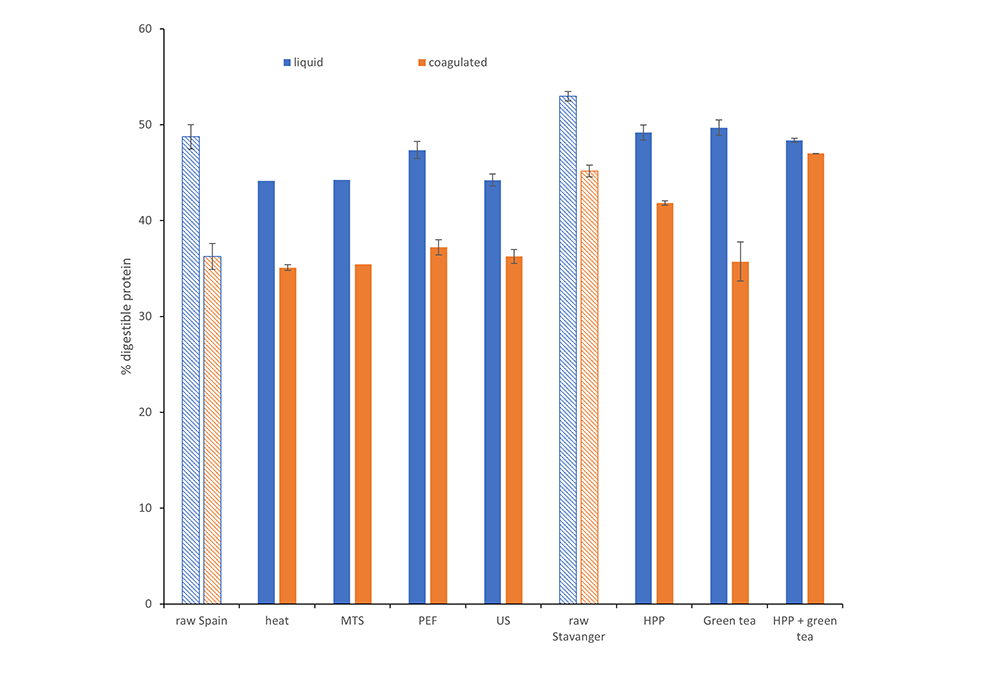We have conducted trials with in vitro digestion of liquid whole egg samples pasteurised using different technologies.
Main conclusions
- For liquid egg samples, all types of pasteurisation slightly reduced protein digestibility compared to raw eggs
- Heat-induced coagulation of eggs (mimicking culinary preparation) had a negative impact on protein digestibility (reduced solubility and reduced protein breakdown) for all samples compared to their liquid counterparts.
- Except for the addition of green tea extract and HPP, which reduced protein digestibility in coagulated egg samples, there was little difference between coagulated samples.
- The negative effect of green tea and HPP on protein digestibility was markedly reduced when used in combination.
- Protein digestibility values for all egg samples with the chosen static in vitro digestion method were generally very low (range 35–53 %) compared to other types of proteins, e.g. casein (87 %) and chicken (73 %).
- No indications of increased peroxidation were found.
Purpose of the trial
Proteins differ in their quality based on both amino acid content, digestibility and bioavailability. Egg is a good source of protein with a high content of essential amino acids, but processing may influence the digestibility. Processing may also affect gastrointestinal oxidative stability and the formation of harmful peroxidation products, e.g. malonaldehyde (MDA).
The purpose of the experiment was to investigate whether different pasteurisation technologies (heat, MTS, US, PEF, HPP) or the addition of green tea extract as a stabiliser would influence protein digestibility and formation of MDA during in vitro digestion of liquid whole egg.
Methods
Samples of liquid whole egg were subjected to different treatments and were stored in frozen form. The samples were thawed and subjected to a static in vitro digestion model (Infogest). Samples were digested in their regular form (liquid) or after an additional heat treatment (coagulated at 70 °C for 20 minutes) designed to mimic culinary preparation. Samples were withdrawn from the gastric and intestinal phases, and protein breakdown products (peptides) were analysed by size exclusion chromatography (SEC). The concentration of dissolved proteins was measured using the Dumas method, and levels of MDA equivalents were measured using the TBARS method (for raw, heat, MTS, US and PEF only).
Treatments:
- Raw (control) – liquid and coagulated
- Heat pasteurised – liquid and coagulated
- Heat + MTS pasteurised – liquid and coagulated
- Heat + US pasteurised – liquid and coagulated
- Heat + PEF pasteurised – liquid and coagulated
- HPP – liquid and coagulated
- Raw + green tea extract – liquid and coagulated
- HPP + green tea extract – liquid and coagulated
What was examined
Protein dissolved during digestion (DUMAS)
For raw, heat pasteurised, MTS, US and PEF-treated samples, the coagulation of samples prior to digestion significantly reduced the amount of dissolved protein during digestion, especially in the gastric phase
For HPP and green tea-treated samples, there was no difference in the protein solubility of liquid or coagulated samples
Protein digestibility (SEC)
Heat treatment (coagulation) of raw, HPP or green tea samples influenced protein digestion by causing reduced degradation of proteins to peptides.
A combination of HPP and green tea extract reduced this negative effect
For heat pasteurised, MTS, US and PEF-treated samples, no clear differences in protein degradation were found.
Lipid peroxidation – formation of MDA during digestion (TBARS)
- Levels of MDA were low in all samples
- Heat pasteurisation, MTS, US and PEF had no effect on MDA formation
- There was no increase of MDA during digestion
- HPP and green tea-treated samples were not analysed for MDA
Hva betyr "in vitro"?
- Forsøk med vev og celler som foregår i glass, reagensrør og lignende I et laboratorium, kalles for “in vitro”-forsøk.
- Om forsøkene gjøres I levende dyr eller mennesker, gjøres forsøkene “in vivo” – som betyr “i det levende”.
Hva er MDA?
- MDA står for malondialdehyder, som er sykdomsfremkallende oksidasjonsprodukter.


